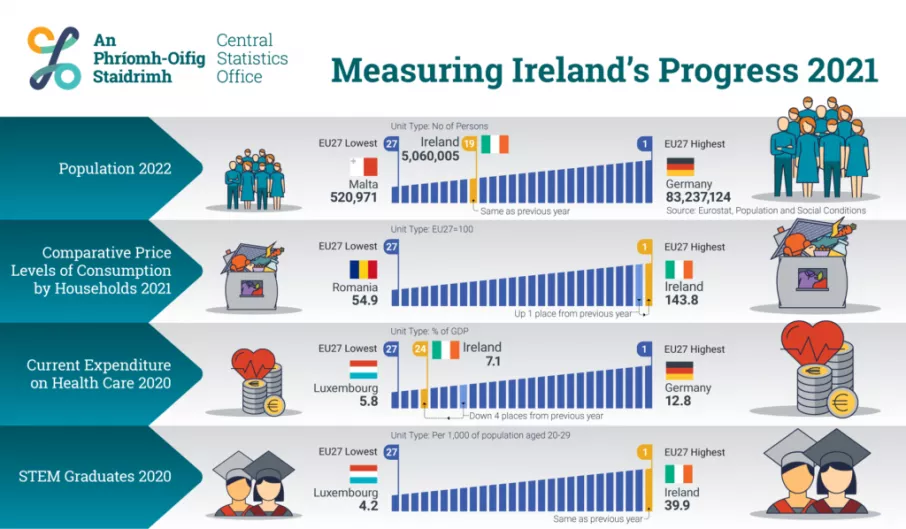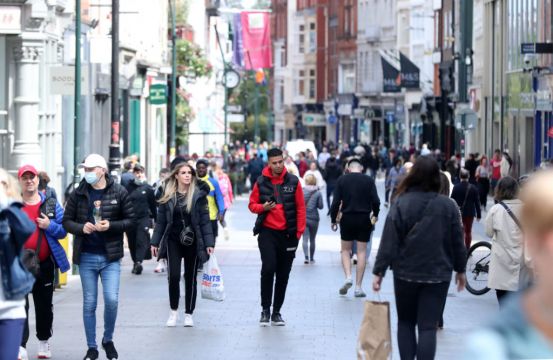Ireland's population growth was the third-largest percentage change in the European Union (EU) according to new figures from the Central Statistics Office (CSO).
'Measuring Ireland's Progress 2021' takes Irish figures on population, economy, health, education and more, comparing and ranking the country in relation to other EU member states.
The CSO stated Ireland's population, which was the ninth smallest in the EU, was estimated at 5.1 million in 2022, showing a 10.3 per cent increase in a 10-year period.
The percentage change was the third-largest noted among the EU's 27 member states during the period, behind just Malta (up 24.8 per cent) and Luxembourg (up 23 per cent).

The data also highlighted Ireland's ageing population, with the portion of people aged under 45 falling from 65 per cent to 59.8 per cent.
Although below the replacement fertility rate - the average number of children which must be born per woman in order to maintain the population to the next generation - of 2.1, Ireland's rate of 1.8 was joint-highest in the EU, matching France, Romania and the Czech Republic.
The figures also found that the life expectancy for Irish males at birth in 2020 was 80.8 years, the highest in the EU, while that of females was 84.4 years, 1.2 years above the EU average.
Finances
Just over 13 per cent of all people in Ireland were found to be at risk of poverty, rising to 19 per cent among people over 65.
The number of people in consistent poverty also rose to 5.3 per cent, up from 4 per cent in 2021, with increased rates noted across all age cohorts.
Median weekly earnings jumped from €530 in 2013 to €629.46 in 2020, with a €129.33 discrepancy between the median for males versus females.
The gender pay gap - the difference between the gross hourly earnings of males compared to that of females - was 9.9 per cent in 2020, 3 percentage points below the EU average.
As a nation, Ireland recorded the largest Gross Domestic Product (GDP) growth, showing an annual increase of 12 per cent last year.
Despite steep inflation as of late, Ireland's inflation of 11.1 per cent between 2018 and 2022 was the sixth-smallest percentage increase in the EU, alongside Finland, falling below the bloc's average of 14.7 per cent.
The CSO noted that price increases have been felt across Europe, particularly since the outbreak of war in Ukraine, with countries in eastern Europe, such as Estonia, Lithuania and Latvia, experiencing the largest inflationary increases.
The figures also showed that employment in Ireland has increased each year between 2012 and 2019, reaching 69.8 per cent before the onset of the Covid-19 pandemic, when the rate slid back to 67.7 per cent. However, it returned to 69.8 per cent in 2021, slightly ahead of the EU's 68.4 per cent average.
Education
The data also examined education across primary to tertiary levels, finding Ireland had the second-highest percentage of people aged 25-34 with a third-level qualification in 2021 at 61.7 per cent.
Ireland also noted the fifth-lowest gender differential in this regard across the 27 countries, with 66.1 per cent of females in the age bracket having a third-level qualification compared to 57.4 per cent of males.
In 2020, Ireland had the highest proportion of graduates from STEM (science, technology, engineering and mathematics) subjects at 39.9 per 1,000 people aged 20-29, in addition to having the highest rate of female STEM graduates - almost twice the EU average.
Irish 15-year-olds also had the third-highest level of reading literacy according to results from 2018 (due to the postponement of the assessment in 2021), while Ireland was 10th and 11th for mathematical and scientific literacy respectively.
For the 2019/2020 academic year, the student-teacher ratio at primary level was 15, putting us above the EU average of 13.6. The ratio at secondary level in 2020 was 12.9.







